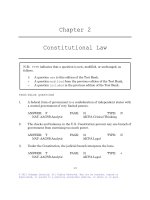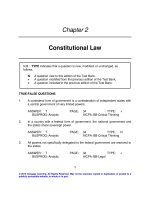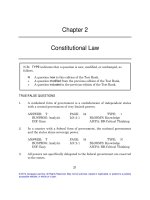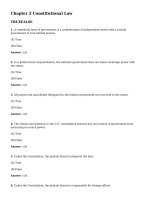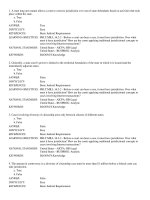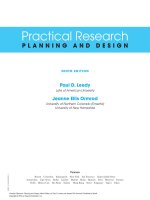Bus law today 9th ed ch01
Bạn đang xem bản rút gọn của tài liệu. Xem và tải ngay bản đầy đủ của tài liệu tại đây (503 KB, 35 trang )
BUSINESS LAW TODAY
Essentials 9th Ed.
Roger LeRoy Miller - Institute for University Studies, Arlington, Texas
Gaylord A. Jentz - University of Texas at Austin, Emeritus
Chapter
1
The Historical and
Constitutional
Foundations
© 2011 Cengage Learning. All Rights Reserved. May not be copied, scanned, or duplicated, in whole or in part, except for use as permitted in
a license distributed with a certain product or service or otherwise on a password-protected website for classroom use.
1
Learning Objectives
What are the four primary sources of law in the
United States?
What is the common law tradition?
What constitutional clause gives the federal
government the power to regulate commercial
activities among the various states?
What constitutional clause allow slaws enacted
by the federal government to take priority over
conflicting state laws?
What is the Bill of Rights? What freedoms are
guaranteed by the First Amendment?
© 2011 Cengage Learning. All Rights Reserved. May not be copied, scanned, or duplicated, in whole or in part, except for use as permitted in
a license distributed with a certain product or service or otherwise on a password-protected website for classroom use.
2
Business Activities and
the Legal Environment
Knowledge of “black letter” law is not
enough.
Many different laws affect a single
business transaction.
Ethics and business decision making.
Ethics: what constitutes right or wrong behavior.
© 2011 Cengage Learning. All Rights Reserved. May not be copied, scanned, or duplicated, in whole or in part, except for use as permitted in
a license distributed with a certain product or service or otherwise on a password-protected website for classroom use.
3
Sources of American Law
Constitutional Law.
Found in text and cases arising from federal and
state constitutions.
U.S. Constitution is the supreme law of the land.
Statutory Law.
Laws enacted by federal and state legislatures.
Local ordinances.
Uniform Laws (e.g.,Uniform Commercial Code).
© 2011 Cengage Learning. All Rights Reserved. May not be copied, scanned, or duplicated, in whole or in part, except for use as permitted in
a license distributed with a certain product or service or otherwise on a password-protected website for classroom use.
4
Sources of American Law
Administrative Law.
Rulemaking--Rules, orders and decisions of
administrative agencies, federal, state and local.
Administrative agencies can be independent
regulatory agency such as the Food and Drug
Administration.
Adjudication--agencies make rules, then
investigate and enforce the rules in
administrative hearings.
© 2011 Cengage Learning. All Rights Reserved. May not be copied, scanned, or duplicated, in whole or in part, except for use as permitted in
a license distributed with a certain product or service or otherwise on a password-protected website for classroom use.
5
The Common Law Tradition
Early English Courts of Law.
King’s courts started after Norman conquest of
1066.
Established the common law—body of general
legal principles applied throughout the English
empire.
King’s courts used precedent to build the
common law.
© 2011 Cengage Learning. All Rights Reserved. May not be copied, scanned, or duplicated, in whole or in part, except for use as permitted in
a license distributed with a certain product or service or otherwise on a password-protected website for classroom use.
6
Stare Decisis
Stare Decisis.
Practice of deciding new cases based on
precedent.
A higher court’s decision based on certain facts
and law, is a binding authority on lower courts.
Helps courts stay efficient.
© 2011 Cengage Learning. All Rights Reserved. May not be copied, scanned, or duplicated, in whole or in part, except for use as permitted in
a license distributed with a certain product or service or otherwise on a password-protected website for classroom use.
7
Equitable Remedies and Courts
of Equity
Remedy: means to enforce a right or
compensate for injury to that right.
Remedy at Law: in king’s courts, remedies
were restricted to damages in either money or
property.
Equitable Remedy: based on justice and fair
dealing a chancery court does what is right:
specific performance, injunction, rescission.
Plaintiffs (injured party initiating the lawsuit),
Defendants (allegedly caused injury).
© 2011 Cengage Learning. All Rights Reserved. May not be copied, scanned, or duplicated, in whole or in part, except for use as permitted in
a license distributed with a certain product or service or otherwise on a password-protected website for classroom use.
8
Exhibit 1-2 Procedural
Differences
© 2011 Cengage Learning. All Rights Reserved. May not be copied, scanned, or duplicated, in whole or in part, except for use as permitted in
a license distributed with a certain product or service or otherwise on a password-protected website for classroom use.
9
Classifications of Law
Substantive vs. Procedural Law.
Substantive: laws that define and regulate rights
and duties.
Procedural: laws that establish methods for
enforcing and protecting rights.
Civil Law and Criminal Law.
Civil: private rights and duties between persons
and government.
Criminal: public wrongs against society.
© 2011 Cengage Learning. All Rights Reserved. May not be copied, scanned, or duplicated, in whole or in part, except for use as permitted in
a license distributed with a certain product or service or otherwise on a password-protected website for classroom use.
10
Classifications of Law
National and International Law.
National: laws of a particular nation.
Civil vs. Common Law: Civil law countries
based on Roman code (e.g., Latin America).
International: body of written and unwritten laws
observed by nations when dealing with each
other.
© 2011 Cengage Learning. All Rights Reserved. May not be copied, scanned, or duplicated, in whole or in part, except for use as permitted in
a license distributed with a certain product or service or otherwise on a password-protected website for classroom use.
11
Constitutional Powers of
Government
A Federal Form of Government:
the
federal constitution was a political
compromise between advocates of state
sovereignty and central government.
Separation of Powers: Executive,
Legislative and Judicial. Provides
checks and balances.
Legislative: enacts laws
Executive: enforces laws
Judicial: declares laws/actions unconstitutional.
© 2011 Cengage Learning. All Rights Reserved. May not be copied, scanned, or duplicated, in whole or in part, except for use as permitted in
a license distributed with a certain product or service or otherwise on a password-protected website for classroom use.
12
The Commerce Clause
U.S. Constitution gives Congress the
power to “regulate Commerce with foreign
Nations, and among the several States,
and with the Indian tribes.” (Art. 1 § 8)
Greatest impact on business than any
other Constitutional provision.
© 2011 Cengage Learning. All Rights Reserved. May not be copied, scanned, or duplicated, in whole or in part, except for use as permitted in
a license distributed with a certain product or service or otherwise on a password-protected website for classroom use.
13
The Commerce Clause
Gibbons v. Ogden (1824).
To Chief Justice Marshall, commerce meant all
business dealings that substantially affected
more than one state.
The national government had the exclusive
power to regulate interstate commerce.
Today:
commerce clause applies to ecommerce internet transactions.
© 2011 Cengage Learning. All Rights Reserved. May not be copied, scanned, or duplicated, in whole or in part, except for use as permitted in
a license distributed with a certain product or service or otherwise on a password-protected website for classroom use.
14
Expansion of National Powers
Wickard v. Filburn (1942).
Purely local production, sale and consumption
of wheat was subject to federal regulation.
CLASSIC CASE 1.1
Heart of Atlanta
Motel v. U.S. (1964). Motel that provided
public accommodations to guests from other
states was subject to federal civil rights legislation.
© 2011 Cengage Learning. All Rights Reserved. May not be copied, scanned, or duplicated, in whole or in part, except for use as permitted in
a license distributed with a certain product or service or otherwise on a password-protected website for classroom use.
15
Commerce Power Today
Theoretically: the federal government has
unlimited control over all business
transactions since any enterprise (in the
aggregate) can have a “substantial effect”
on interstate commerce.
Practical Limits: Supreme Court has
curbed federal regulatory powers in U.S. v.
Lopez (1995) and U.S. v. Morrison (2000).
© 2011 Cengage Learning. All Rights Reserved. May not be copied, scanned, or duplicated, in whole or in part, except for use as permitted in
a license distributed with a certain product or service or otherwise on a password-protected website for classroom use.
16
Regulatory Powers of the States
Tenth Amendment reserves all powers to
the states that have not been expressly
delegated to the national government.
State have inherent “police powers.”
Police powers include right to regulate health,
safety, morals and general welfare.
Includes licensing, building codes, parking
regulations and zoning restrictions.
“Dormant” Commerce Clause
© 2011 Cengage Learning. All Rights Reserved. May not be copied, scanned, or duplicated, in whole or in part, except for use as permitted in
a license distributed with a certain product or service or otherwise on a password-protected website for classroom use.
17
Dormant Commerce Clause
U.S. Supreme Court has interpreted
commerce clause to give national
government exclusive power to regulate.
States only have a “dormant” (negative)
power to regulate interstate commerce.
Dormant power comes into play when
courts balance state’s interest vs. national
interest, e.g., internet transactions.
© 2011 Cengage Learning. All Rights Reserved. May not be copied, scanned, or duplicated, in whole or in part, except for use as permitted in
a license distributed with a certain product or service or otherwise on a password-protected website for classroom use.
18
The Supremacy Clause
Supremacy Clause: Article VI of the
Constitution provides that Constitution,
laws and treaties of the United States are
the “supreme law of the land.”
Concurrent: in few areas, both states
and federal government share powers.
Preemption: when Congress chooses to
act in a concurrent area, federal law
preempts state law.
© 2011 Cengage Learning. All Rights Reserved. May not be copied, scanned, or duplicated, in whole or in part, except for use as permitted in
a license distributed with a certain product or service or otherwise on a password-protected website for classroom use.
19
Business and the Bill of Rights
1791: Ten written guarantees of protection
of individual liberties from government
interference.
Originally: Bill of Rights only applied to the
federal government.
Today: the Bill of Rights has been
“incorporated” and applied to the States as
well.
Some protections apply to businesses.
© 2011 Cengage Learning. All Rights Reserved. May not be copied, scanned, or duplicated, in whole or in part, except for use as permitted in
a license distributed with a certain product or service or otherwise on a password-protected website for classroom use.
20
First Amendment: Freedom of
Speech
Right to Free Speech is the basis for our
democratic government.
Symbolic Speech: includes gestures,
movements, articles of clothing.
Texas v. Johnson (U.S. 1989).
Hodgkins v. Peterson (7th Cir. 2004).
Reasonable Restrictions: balance
government’s obligation to protect
community vs. individuals right to speech.
© 2011 Cengage Learning. All Rights Reserved. May not be copied, scanned, or duplicated, in whole or in part, except for use as permitted in
a license distributed with a certain product or service or otherwise on a password-protected website for classroom use.
21
Corporate Political Speech
Corporations also have protected
political speech (although not to the
degree of a natural person).
Supreme Court struck down campaignreform finance laws as unconstitutional
burden on corporate speech (FEC v.
Wisconsin Right to Life).
© 2011 Cengage Learning. All Rights Reserved. May not be copied, scanned, or duplicated, in whole or in part, except for use as permitted in
a license distributed with a certain product or service or otherwise on a password-protected website for classroom use.
22
Commercial Speech
Commercial speech is given substantial
protection. Generally, government restrictions
must:
Seek to implement substantial government interest,
Directly advance that interest, and
Must go no further than necessary to accomplish.
CASE 1.2
Bad Frog Brewery, Inc. v. N.Y. State
Liquor Authority (1998). Denial of label on beer
lacked a “reasonable fit” with state’s interest in
shielding minors from vulgarity, and was therefore
unconstitutional.
© 2011 Cengage Learning. All Rights Reserved. May not be copied, scanned, or duplicated, in whole or in part, except for use as permitted in
a license distributed with a certain product or service or otherwise on a password-protected website for classroom use.
23
Unprotected Speech
U.S. Supreme Court has held that certain
speech is NOT protected:
Defamatory speech.
Threatening speech that violates criminal laws.
Fighting Words.
Obscene Speech is patently offensive, violates
community standards and has no literary,
artistic, political or scientific merit.
© 2011 Cengage Learning. All Rights Reserved. May not be copied, scanned, or duplicated, in whole or in part, except for use as permitted in
a license distributed with a certain product or service or otherwise on a password-protected website for classroom use.
24
Online Obscenity
Protected or Unprotected?
Some of Congress’ attempts to protect children
from online pornography have been ruled
unconstitutional restriction on free speech.
•
•
•
Communications Decency Act (1996).
COPA (1998-challenged, in court).
Children’s Internet Protection Act (2000) which
requires filters for computers in public libraries and
public schools). Challenged, in court.
What about “hate” speech on the web?
© 2011 Cengage Learning. All Rights Reserved. May not be copied, scanned, or duplicated, in whole or in part, except for use as permitted in
a license distributed with a certain product or service or otherwise on a password-protected website for classroom use.
25

